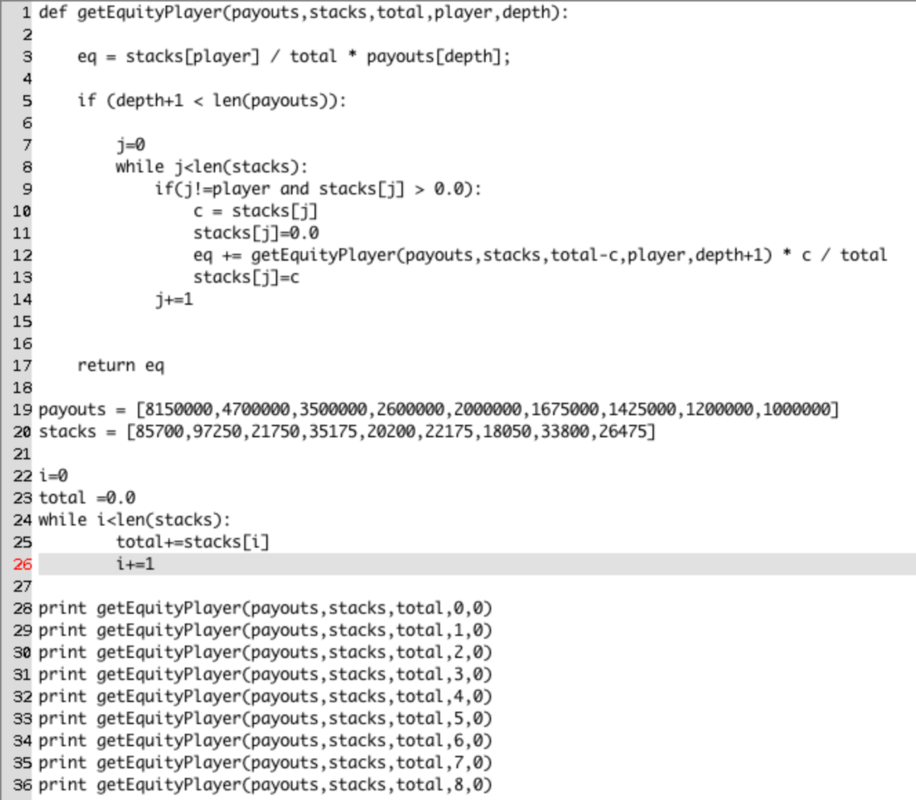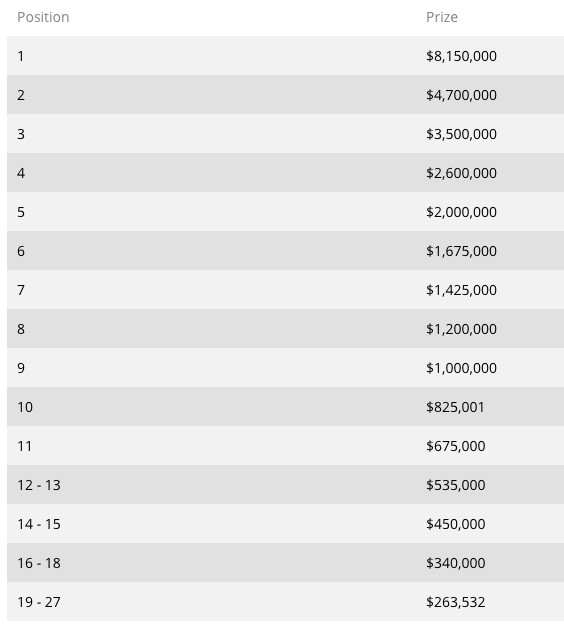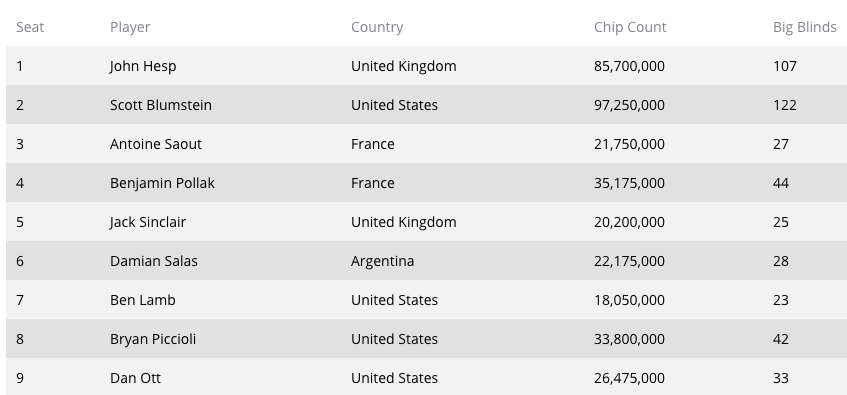The 7,221 person field is down to 9 players that are playing for an $8,000,000 first place prize. You can read the recaps of each day over on pokernews.
You can also read the final table player profiles on pokernews:
- Scott Blumstein
- John Hesp
- Antoine Saout
- Benjamin Pollak
- Jack Sinclair
- Bryan Piccioli
- Dan Ott
- Ben Lamb
- Damian Salas
A Brief Lesson in Independent Chip Modeling
Independent Chip Modeling (ICM) is a method of calculating someone's real money equity based on the chipstacks and the tournament payouts. In a cash game, if one person has $300 in front of him, one has $400, and one has $500, then that is how much each of those stacks are worth. However, in tournaments, adding payouts for finishing positions complicates things.
Let's walk through a simple example:
Suppose there are 3 players left in a tournament with stacks 9000, 6000, 5000.
The payouts are $1000 to first, $600 second, and $400 third place.
To figure out each player's equity, we must find how often they finish 1st, second and third, then multiply those percentages by the payouts. We do these calculations as if all players have equal skill level.
There are 20000 total chips in play, so assuming all three players have equal skill, then player 1 should win 45%, player 2 wins 30%, and player 3 wins 25%, because that is the percentage of chips each player has in play.
How often does Player 1 finish second?
For player 1 to finish second, we must assume another player wins. Player 2 wins 30%, and Player 3 wins 25%.
When player 2 wins, player 1 has 9000/(9000+5000) of the remaining chips, which we multiply by 30% for when player 2 wins. Thus, player 2 wins, player 1 finishes second, and player 3 finishes 3rd .3 * (9/14), which is ~19.28%.
Do a similar calculation for when player 3 wins. Player 1 has 9000/(9000+6000) of the remaining chips, which we multiply by 25% for when player 3 wins. This happens .25*(9/15) = 15%
We can add these together to figure out how often player 1 finishes in each position.
Player 1 wins 45%.
Player 1 finishes second ~34.28%
Player 1 finishes third ~20.72%.
Multiply these by each payout to receive his equity
Equity = .45 * $1000 + .3428 * $600 + .2072 * $400 = $738.56
Do these calculations for every player and every finishing position and you can calculate everyone's equity.
Knowing equities is important because decisions are not just about whether or not something is +EV in terms of just chips. Sometimes you will have to pass up an edge because it makes more sense to keep your stack equity.
To avoid doing really complicated math, let me just show this through a simple example. Suppose there are 6 players left in a tournament that awards 5 seats to the main event next year. First place through 5th place all receive the same prize. Now suppose you are 2nd in chips, and the following are the chipstacks of players: 10000, 9000, 4000, 3000, 2000, 1000.
If the biggest stack goes all in, you should fold AA! You will likely only win the hand 85-90% of the time, but you will qualify far more often than that if you fold because you can just wait til one of the shortstacks busts and you make the maximum.
They are tough calculations because so much is involved: you can't just figure out how often someone finishes each position quickly because it depends on how often each other player finishes in each position.
Add more players and it becomes even more complex. So I wrote a computer program that recursively goes through and calculates each player's equity based on the stacks and payouts.

I already entered the payouts and stacks of the final tablists.
Payouts, Stacks, and Equities for Final Tablists
Payouts:

Stacks:

Equities:
- John Hesp: $4,334,468.28
- Scott Blumstein: $4,577,518.70
- Antoine Saout: $2,324,806.94
- Benjamin Pollak: $2,894,979.55
- Jack Sinclair: $2,249,417.31
- Damian Salas: $2,345,062.87
- Ben Lamb: $2,140,620.30
- Bryan Piccioli: $2,842,232.79
- Dan Ott: $2,540,893.26
Even though Scott Blumstein has nearly triple anyone other than John Hesp, he still doesn't have as much equity as finishing second place! The shorter stacks equities are all bunched up: despite having half as many chips as Benjamin Pollak, Ben Lamb's stack has 3/4 as much equity.
As stated, this does not take into account skill level or where the button starts.
You can slightly adjust equities based on the edge they have over the field, and also based on where they start in relation to the blinds. For instance, the button starts in seat 2 tomorrow, so Scott Blumstein's equity is slightly higher than what is listed, while the players in seats 3-7 are probably slightly lower than those listed.
Ben Lamb is the strongest player remaining, but he's also short stacked so it will be hard for him to gain much off his skill edge, but we can still raise his equity some from those numbers.
These numbers are just a solid general guideline to help players make decisions.
They're also fun to know. Everyone remaining is guaranteed at least a $1,000,000 payday, but everyone remaining has at least $2,000,000 of equity.
I'll write a blog later today analyzing one of the big hands on the final table bubble and showing how these ICM calculations play a role.
My name is Ryan Daut and I'd love to have you as a follower. Click here to go to my page, then click  in the upper right corner if you would like to see my blogs and articles regularly.
in the upper right corner if you would like to see my blogs and articles regularly.

I am a professional gambler, and my interests include poker, fantasy sports, football, basketball, MMA, health and fitness, rock climbing, mathematics, astrophysics, cryptocurrency, and computer gaming.
